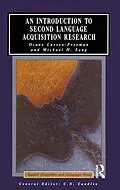Understanding how people learn and fail to learn second and foreign languages is increasingly recognised as a critical social and psycholinguistic issue. Second languages are vitally important to diverse groups of people, ranging from refugees to college students facing foreign language requirements. This book provides a synthesis of empirical findings on second and foreign language learning by children and adults, emphasising the design and execution of appropriate research.
Autorentext
Diane Larsen-Freeman, Michael H. Long
Inhalt
Preface Acknowledgements 1. Introduction 2. Second language acquisition research methodology 3. SLA - Types of data analysis 4. Interlanguage studies: Substantive findings 5. The linguistic environment for language acquisition 6. Explanations for differential success among second language learners 7. Theories in second language acquisition 8. Instructed second language acquisition Bibliography Index
